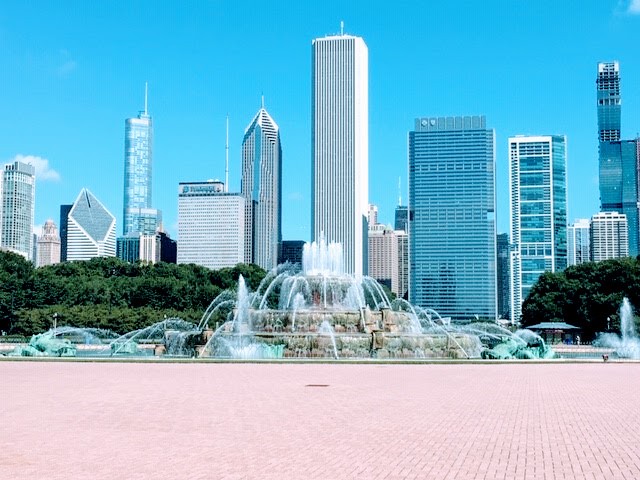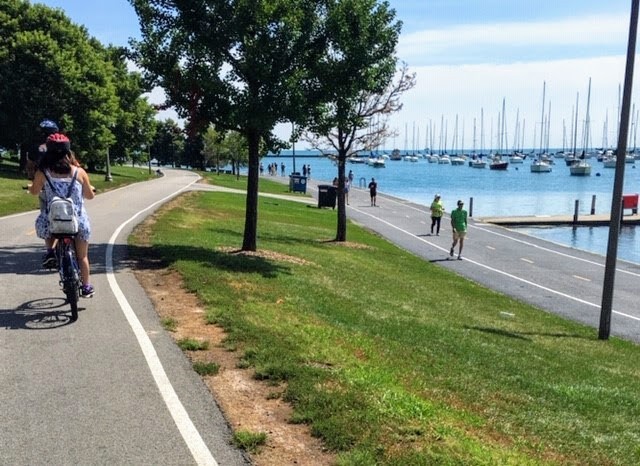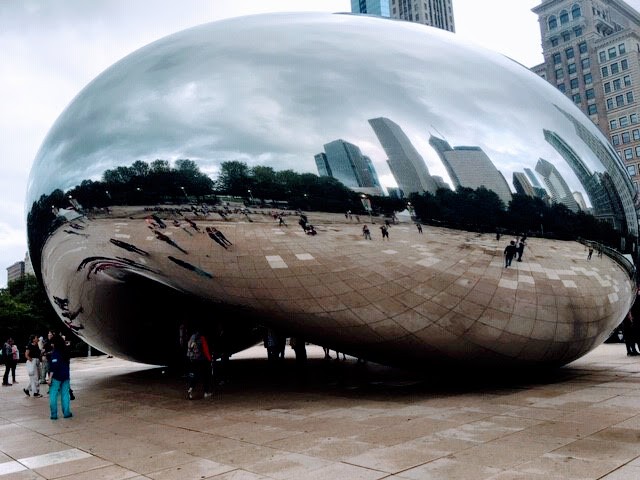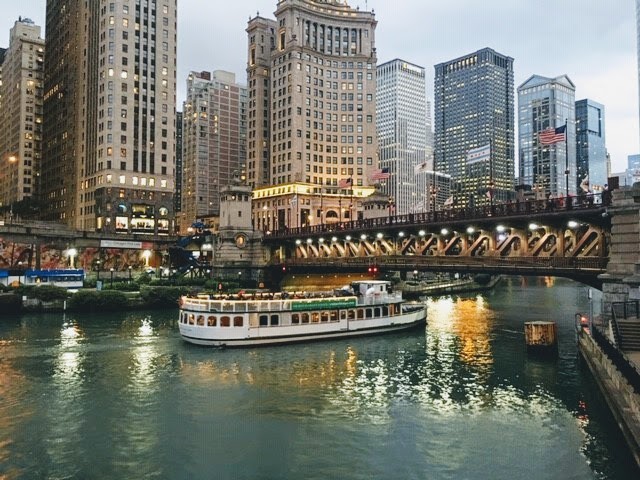Chicago is well known for its gorgeous blue lakefront but a lesser-known fact is that it’s also gone green.
Yes, the city with the third-largest population in the States, filled with magnificent architecture and a fascinating crime history is also at the forefront of eco-conscious tourism. Chicago committed to going green about two decades ago, long before it became trendy, and it now boasts an impressive array of restaurants and hotels that encompass the best eco-friendly practices in the U.S.

The city skyline and gorgeous Buckingham Fountain. Photo Denise Davy
The city has done such an excellent job that Business Facilities magazine named Chicago the greenest city in America. And for a good reason. It has more than 500 green rooftops and 13 rooftop farms which are cultivated by local chefs who then harvest the produce for their restaurants. That adds up to more than seven million square feet of green rooftops, more than any other city in the U.S. Not only do many of the gardens produce organic ingredients, but green roofs improve air quality, conserve energy, reduce stormwater runoff and help lessen the urban heat island effect.
I love to travel and would also like to travel in more eco-friendly ways. It turns out I’m not alone. According to a TripAdvisor survey, eco-friendly travel is being practised by almost two-thirds of travellers who are looking for “green” hotels and restaurants. They’re also making more environmentally sound choices by turning off hotel room lights, reusing linens and towels and recycling.
Here’s how to be an eco-tourist in Chicago:
Getting there:
Coincidentally, the week I was planning my trip to Chicago, 16-year-old Swedish climate change activist Greta Thunberg boarded a sailboat and sailed across the ocean to New York to attend the United Nations conference. Her choice of transportation made a bold statement about the dangers of carbon emissions from planes.
In the same week, the Washington Post published an article on how we could save the planet if we just flew less because of the excessive amount of carbon dioxide pumped into the atmosphere during air travel. So if I was to be a true eco-tourist, flying was off-limits. Trains are more environmentally friendly, but with no direct train to Chicago from Toronto, it would take upwards of 13 hours. Thus the decision was made to drive.
Although it took seven and a half hours, it was an easy drive with lots of greenery along the way and long stretches on main highways. It was also more financially healthy. Rather than spending $1,800 on airfare (for three people), it cost us around $120 for gas and $150 for parking for five days.
If that seems like a long time to drive, consider how long it takes to fly. I estimated with travel time to the airport, having to be there two hours in advance, then getting to our hotel, it would have taken us almost as much time to fly.
For all of the stories I’d heard about the crazy Chicago traffic, getting around the city was a breeze. Note: For those who have no alternative but to fly, Chicago’s O’Hare Airport boasts an apiary and vertical garden, which are good for the environment.
Where to Stay:
If you’re going to practice green travel, choosing the right hotel is paramount. Hotels spew out gallons of water and throw away half-used plastic shampoo bottles by the thousands. After much research, the Fairmont Millennium Park Hotel stood out as its commitment to being green went beyond its day to day practices.
The hotel saves on water by washing sheets every other day, and all of their paper products meet LEED standards. I also liked that their guest room amenities aren’t tested on animals. All the fresh produce they serve is purchased from local farmers, and they use fluorescent light bulbs and water-efficient showerheads and taps. On top of that, the location was very central, which made it easy for us to walk everywhere. It was a few blocks from the main street and a comfortable walk from sites like Millennium Park, The Art Institute of Chicago and CIBC theatre. From strictly a comfort viewpoint, the beds were super comfy, suites were spacious, and the view of Lake Michigan was fantastic.
Where to Eat:
Can a vegetarian find happiness in a city known for its deep-dish pizza pepperoni pizzas and all-beef hot dogs? Going vegetarian is definitely good for the planet, says a report by the United Nations which suggests eating less meat and reducing food waste could slash global emissions and benefit our health.
We were delighted to come across countless vegetarian and vegan restaurants. Many others had eco-friendly policies and used local food, composted their kitchen waste and recycled their cooking oils and other debris. An easy way to find eco-friendly restaurants is to google the Green Restaurant Association or Green Seal as they list all restaurants that have received their certifications.
Uncommon Ground tops the list for eco-friendly restaurants in Chicago. It was the first restaurant in the U.S. to have a certified organic rooftop farm and has a 2,500-square-foot rooftop production garden and five rooftop solar panels that heat water for the restaurant. Owners Michael and Helen Cameron use only ecological cleaning supplies, high-efficiency light bulbs, solar hot water, and they also support local artists by featuring their work in the restaurants.

Our delicious meal at the Kaliflower restaurant and we had a front run seat for people watching. Photo Denise Davy
We visited Kaliflower on our second night, and while it was small, it served up some big choices and deliciously healthy meals. I had the Tikka Trail that came with tikka sauce, marinated kale, and was topped with cucumber mint yogurt, chopped cilantro, crispy chickpeas and lemon.
The Wildberry Pancakes and Cafe on E. Randolph Street was a few minutes from our hotel, and their menu overflowed with vegetarian options. They included vegan breakfast hash, gluten-free avocado toast and kale and quinoa vegan salad. I liked that they used local farm-fresh ingredients, and everything was delicious. We enjoyed our meal so much that we went back the next day and had their delicious pancakes.

Wildberry’s definitely didn’t scrimp on the pancakes. Photo Denise Davy
What to Do:
Walking tours and bike tours are a great way to make your trip more eco-friendly, and in Chicago, both were easy to find. I signed up with Bobby’s Bike Hike for their lakefront tour which would take us along the 26-mile lakefront path for bikes.
Our tour guide Robert was super friendly and took us through the streets and along the path, stopping to talk about the city’s history and pointing out sites like the gorgeous Buckingham Fountain. I really appreciated the high-quality bikes as it made the hour and a half ride super comfortable.

The bike path is close to the lake. Photo Denise Davy
You haven’t seen Chicago until you’ve seen it from the lakefront and seeing it by bike provided the best view ever. Robert delved deep into the city’s history and gave us a test on what the four red stars stand for on the city’s flag. He also shared the popular theory on how the town earned its Windy City nickname and, no, it’s not due to the frigid breezes that blow off Lake Michigan. It was during the 1890s when Chicago was rebuilding from the great fire of 1871, all of their boasting about their new beautiful city prompted a New York columnist to respond that they were a bunch of windbags.
Millennium Park is a must-see when you’re doing Chicago as an eco-tourist as it’s a 25-acre example of how a city can provide park space and be eco-conscious at the same time. The park is not only a gorgeous meeting spot for locals and tourists, but it covers an unsightly underground parking garage, providing a beautiful ecosystem in the middle of downtown Chicago, and is the most extensive green roof in the world. The beauty of green roofs is that they reduce surface temperature and heating and cooling costs, and at the same time, they’re fun.

The Bean in Millennium Park is possibly Chicago’s most popular tourist spot. Photo Denise Davy
The park was our first stop when we arrived in Chicago as I thought it would be an excellent way to wind down. The attractions are second to none, especially for families with young children as it is very family-friendly and includes a rock climbing area, swings, playground and miniature golf.
We headed for the infamous Cloud Gate, AKA, the Bean, which is one of the world’s largest outdoor monuments and is made of highly polished stainless steel. It was designed as a mirror and reflects the sights around the park.
Also popular in the park is Crown Fountain which is made of two 50-foot towers at each end of a shallow reflecting pool. There are more than 1,000 faces of Chicagoans projected onto the tall towers, individually, and it’s probably the most unique fountain I’ve ever seen. As kids splashed in the pool, we sat on the bench and watched the facial expressions on the towers change and water spout out of the mouths.

The Crown Fountain in Millenium Park was in constant movement as the facial expressions changed. Photo Denise Davy
The Art Institute of Chicago houses some of the most exceptional art in the world, including the American Gothic, but a little known fact is that it’s also a leader in eco-friendly practices. In 2005, a network of institutions came together to make their buildings more sustainable, and the city’s Green Museums Initiative was developed to bring sustainability to the city’s museums.

The famous American Gothic painting draws lots of visitors to the Art Institute of Chicago. Photo Denise Davy
Where it’s most apparent is in the Modern Wing, which was built to maximise natural sources of energy and minimise waste. It’s been described as one of the finest examples of green architecture in the world. The sunshade is referred to as the “flying carpet” and filters daylight into the upper-level gallery spaces.
The screen saves electricity consumption while helping to achieve ideal lighting conditions during the day. For visitors, the lighting automatically adjusts, providing perfect light while also saving electricity.
Shedd Aquarium is one of Chicago’s ten museums, which include the Field Museum, all of which have pioneered environmentally friendly practices, from green business operations to green exhibits.

The twilight river cruise offered by the Chicago Architecture Center showed off the city’s amazing skyline. Photo Denise Davy
The river that runs through Chicago is as much a part of the city’s identity as is the shoreline, so a river cruise was a must during our visit. In keeping with our eco theme, I chose the cruise run by the Chicago Architecture Centre which practices eco-friendly tourism by fuelling their vessels with only clean energy sources. The twilight river cruise is a one-of-a-kind experience. The boat sails up the river during the day and comes back at night so you see the city sparkle from the sun reflecting off the buildings and then at night it becomes the city of lights.
The author travelled to Chicago in August 2019 with her family and was a guest of Fairmont Millennium Park Hotel, Bobby’s Bike Hike, Chicago Architecture Centre and Choose Chicago. None of the facilities reviewed or approved this article.



